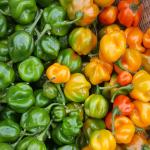Growing Chilli peppers, also Hot peppers
Capsicum sp. : Solanaceae / the nightshade family
| Jan | Feb | Mar | Apr | May | Jun | Jul | Aug | Sep | Oct | Nov | Dec |
|---|---|---|---|---|---|---|---|---|---|---|---|
| S | S | S | S | S | S | S | |||||
| T | T | T | T | T | T |
(Best months for growing Chilli peppers in Australia - sub-tropical regions)
- S = Plant undercover in seed trays
- T = Plant out (transplant) seedlings
- Grow in seed trays, and plant out in 4-6 weeks. Sow seed at a depth approximately three times the diameter of the seed. Best planted at soil temperatures between 18°C and 35°C.
- Space plants: 40 - 50 cm apart
- Harvest in 9-11 weeks. Wear gloves to pick 'hot' chillies.
- Compatible with (can grow beside): Best grown in a separate bed as chillies need plenty of light and air circulation.
Small bushy plants. Dark green ovate leaves.
Chilli need warm frost free weather, so protect with glass or plastic covers if planting outside in cooler areas.
Most varieties need a long growing period to produce many fruit.
There are many types of chilli. Some are more fiery than others. As a general rule, the smaller the pod the hotter the taste.
Culinary hints - cooking and eating Chilli peppers
Chillies freeze very well. Wash, dry, and free whole. Use them direct from the freezer (no need to defrost).
Wear plastic gloves or wash your hands thoroughly after handling and cutting to avoid accidentally rubbing chilli juice onto your mouth or eyes!



Your comments and tips